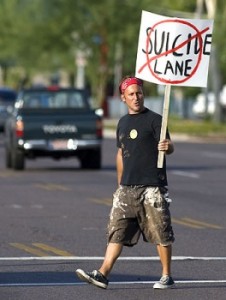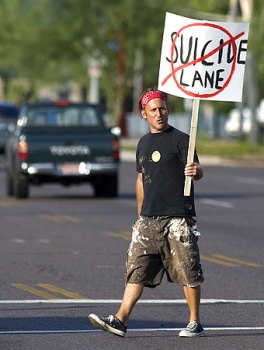 Today’s post is by the avid urbanist, community activist and my friend, Yuri Artibise.
Today’s post is by the avid urbanist, community activist and my friend, Yuri Artibise.
Yuri Artibise—aka the Incurable Urbanist—has spent the past four years creating community in the urban desert that is better known as Phoenix. Through his Yurbanism brand, Yuri explores the ‘Y’ of urbanism by sharing ways to make our cities more livable, community-oriented places one block at a time. Find out more at yuriartibise.com.
On December 14th Phoenix City Council voted 5-1 (with 2 absences) to accept the report of the Ad Hoc Task Force on Reverse Lanes. (A summary of the report is found at the end of this document.) The report recommended maintaining the reverse lanes with minor adjustments and future study. This was a frustrating day for those who are fighting for a vibrant and livable central Phoenix.
I applaud the Ad Hoc Task Force for their diligence in carrying out the almost impossible task of studying and making recommendations on the Reverse Lanes. I am disappointed, however, that they only studied half of the issue. In particular, the only solid data presented during the public hearings dealt with automobile traffic. Little attention was paid to small business vitality or local livability. No attention was given to the impact of the reverse lanes on pedestrians, cyclists, school children and transit users.
I have lauded the City of Phoenix in the past for their investment in the Melrose on 7th Ave streetscape, including the recently installed pedestrian controlled HAWK light. City Council’s refusal to remove the reverse lanes (even temporarily) undermines this investment. It indicates that they continue to view 7th Ave and 7th St as thruways to and from other destinations and not as vibrant communities for socializing and enjoying public art, restaurants and small businesses.
This support for the continuation of the status quo is even more frustrating in light of the City’s stated commitment to sustainability. The opening of the light rail indicated that City Hall was beginning to rethink Phoenix’s relationship with cars and recognize the role that streets play in shaping places for everybody to enjoy, whether they are in cars or not. Refusing even to temporarily suspend the reverse lanes is a step backwards and another sign that sustainable community is little more than a catchphrase at 200 W Washington.
In her closing remarks at the City Council meeting, Melrose Pharmacy owner Teresa Stickler asked City Council members whether we as Phoenicians want our motto to be: ”Phoenix, a great city to live in,” instead of “Phoenix, the fastest city to get out of.” By rejecting even temporarily removing the lanes, City Council, with only one dissenter, indicated that they still feel that cars are more important than community in this city.
While we may have lost this round, the fight will continue. We will build on the support that we received and continue to raise awareness that there is more to life in Phoenix than commuting by car. City Council will meet again in about six months to review the implementation of the accepted recommendations. In August 2011, Phoenix will have municipal elections for half of the Council and a new mayor. Both of these events will give us another opportunity to press City Council to do the right thing and—at a minimum—approve a temporary removal of the reverse lanes so real traffic (including pedestrians and bicycle), safety, economic development and community data can be gathered. The neighborhoods will be able to handle reinstating the lanes if we know they are needed. The continuation of community suffering due to unsubstantiated fears of increased commuting times is an insult to central Phoenix.
Photo Credit: Photograph by Tom Tingle/The Arizona Republic




















It was so frustrating going to the reverse lane meetings and having a traffic engineer do the presentation. Its not too shocking when his findings point the audience towards the idea that the Reverse lanes ought to stay! The City desperately needs to embrace the idea of “complete streets.”
Yesterday I was shopping at “All About Books & Comics” on Central, since it was so lovely out and I had time to kill before meeting a friend on the LRT to go to the Insight Bowl I decided to take a walk.
I walked across Central and through the Medlock Place Historic district. I walked East on Medlock, North on 6th Street and then East on Colter out onto 7th. As soon as I hit 7th street though I didn’t want to continue, lane after lane of traffic blowing by at 55mph makes it a very scary place for a pedestrian. Further the sidewalk abuts the street directly, with no method of shade of protection for the pedestrian.
What I’d like to see is the “Suicide Lanes” done away with permanently and planter strips added between the sidewalk and street. Another rather narrow planter strip could be added as a median to help divide the traffic traveling in opposite directions. The planter strips would beautify the 7’s, help soften the often times oppressive ugliness of the built environment and of most importantly make things feel safer for pedestrians, which means more walking and more shopping at local businesses (and hello City, more sales tax dollars!)
Let me begin by saying that I do not like the reverse lanes. But there are a lot of things that large numbers of people living together in one location bring that can be not “community”, freeways for example. We also have a downtown designed around 1950 traffic patterns in a car oriented past. This of course needs to change.
The removal of the lanes would cause congestion at 8 arterial intersections for each street. Frustrated communters would blast through the last minute yellows and t-bone the now allowed turning traffic….this is the most serious cause of death and injury accident in the city. With the I-10 causing a funnel effect on the sevens the traffic would back up from the lights on Thomas…..now imagine all those commuters sitting through 5 light changes rather than one or two…..as the look to the left and right they see escape through our historic neighborhoods, soo they “discover” the new way to avoid that congestion. 12th and 10th Streets through Coronado? 3rd and 5th through Willo? I currently live on what is the alternate for the left turn at 7th and McDowell, believe me these folks after 30 minutes at 45mph, don’t seem to slow down. So lets get them out of town safely and quickly and begin to work on viable plans to end the dependency on commuting…..this begins with the neighborhooods realizing that we need density on some of the vacant land along McDowell Road that would tie into the light rail and activity downtown. A handful of activist has made this vision a zoning nightmare for any developer who was even considering density…..they now are advised by zoning attornies to go elsewhere…..we sit with empty lots, lacking in property tax revenue, and abandoned historic storefronts due to the lack of a customer base beyond beer, check cashing and dollar stores. It is impossible to fit the vision of the future into what was the past. We need to preserve the historical past, and integrate it with a vision of a urban future…..this is not by longing for Phoenix as it was in 1950. The communter will be with us until we move back to location where we work and play. If there is nowhere to move that is a moot point.
The sevens even without the reverse lanes are not safe streets for walking or biking…4 traffic lanes and a turn lane in the center…..I would not want to cross, I even hesitate making the left when we can……Thanks for listening to another opinion….
Yuri and Taz,
I applaud your determination to raise this issue. I’ve heard these suicide lanes mentioned in casual conversation but never as an element of community. Thanks for bringing forth other sides of an important issue.
[…] Avenue, especially during the morning and afternoon rush hours can be anything but bike-friendly. But there is this HAWK (High-Intensity Activated crossWalK) […]